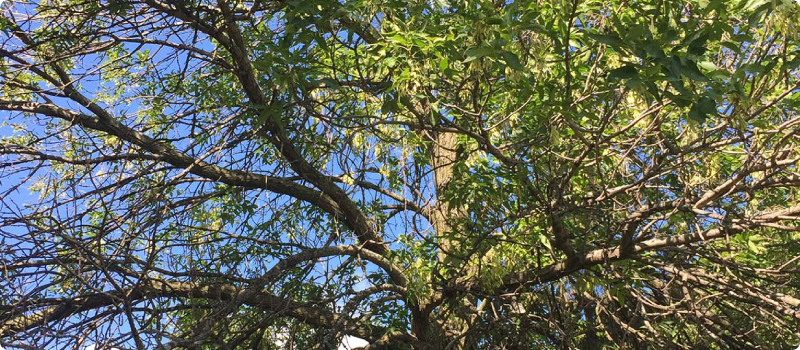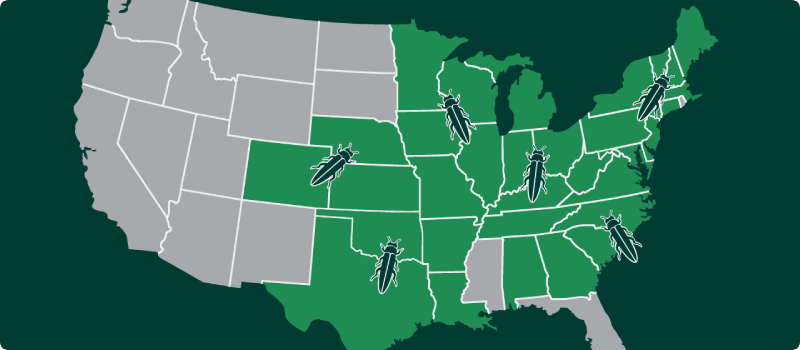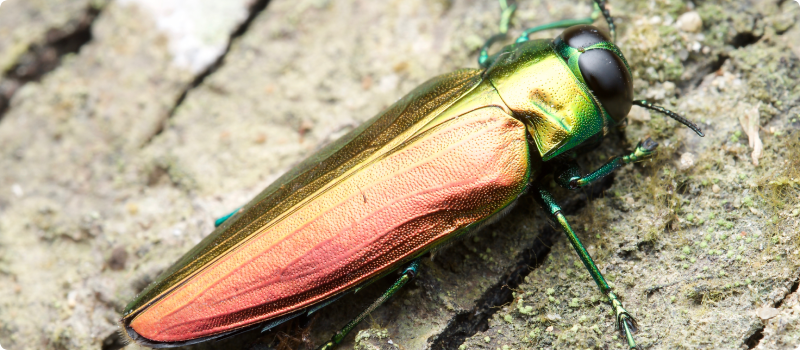Eggs, larvae and pupae can all survive in firewood if it is transported — even if it is stored over the winter — so
you should be careful about transporting firewood all year round.
How do I identify emerald ash borer damage?
An emerald ash borer infestation can kill a young ash tree in as little as a year if left untreated, so early
detection is crucial. Thankfully, with a little awareness and education, early detection can be as easy as looking
out of your window.
Healthy ash trees should have dense green foliage, without any bare or sparse branches. Branches should
bend, rather than break, and there should be an absence of dead or broken branches.
Early signs of emerald ash borer damage are most visible at the top of the tree, called the crown or canopy.
The first sign is often yellowing or browning leaves at the very top of the tree, followed by leaf die-back that
results in branches with few or no leaves. Be sure to stand far back from your ash tree when inspecting the
crown, as it can be nearly impossible to tell if there has been thinning or leaf die-back if you are standing too
close. Up close, you may notice small notches in leaves where adult emerald ash borers have been feeding.
A sudden increase in woodpecker activity can also be a sign of infestation. Woodpeckers are known to dine on
emerald ash borer larvae, so if you’re rudely woken by a number of woodpeckers pecking at your tree one
morning, there could be a good chance they’re trying to score an emerald ash borer breakfast. Sometimes
enthusiastic woodpeckers can even cause something called “blonding,” where the tree trunk appears paler
because the hungry birds have stripped away so much of the outer bark.
During the summer, you can cut away a small portion of a tree’s bark and sapwood. A telltale sign of infestation
are the unique serpentine tunnels or galleries created by the feeding larvae. You may even spot larvae in these
galleries!
Later signs of infestation include a dull, sickly crown where the leaves are no longer vibrant, healthy or plentiful.
You may also find tiny, D-shaped holes where adult beetles have emerged. Other signs of advanced infestations
include splitting gashes in the trunk from calluses formed below the bark after substantial internal ash borer
damage, or strange foliage sprouting from the trunk or roots with larger-than-normal leaves.
Key signs of emerald ash borer disease:
Yellow, thinning or wilting leaves
S-shaped tunnels under the bark
Peeling bark
Defoliation of leaves
D-shaped holes in the bark
Unusual woodpecker activity
Strange growth at trunk or roots
Upright shoot growth
How to Get Rid of Emerald Ash Borer
The first step to action is taking an inventory of your ash trees. Determine how many ash trees you have, where they are and whether you want to treat the infestation or remove the affected trees. If trees are left untreated, they are unlikely to recover and can die within a handful of years.
Next, you’ll want to consult the aid of an arborist or tree care professional. Arborists are certified tree specialists who could be thought of as “tree doctors.” They can verify that emerald ash borers — and not a different pest — are infesting your trees, and help you decide whether emerald ash borer treatment or removal of the affected trees is the best option for you, your yard and your wallet. They can also help you determine if it’s a good idea to apply a preventative emerald ash borer treatment to any ash trees in your yard not yet infested.
If you decide not to treat or remove an infested tree, an arborist will also be able to assess the situation and make helpful recommendations that could prevent hazards and damage to your, or your neighbor’s property, if the afflicted tree dies.

Emerald Ash Tree Borer Treatment
Deciding whether to treat or remove an infested tree is a tough choice that expert Wayne Rayfield knows all too well. A landscape professional with over 30 years of experience, including over 20 years as a college instructor for landscape design, he now works as a land management administrator who helps maintain American Family Insurance’s 450-acre National Headquarters. Over the years, he’s had to deal with several emerald ash borer infestations.
When making the tough decision to keep or replace an ash tree, Wayne advises homeowners to consider four factors: the tree’s sentimental value, its size and health, its location on the property and the cost of emerald ash borer treatment.
First some sentimental value. “If you have a real stately tree that’s got the kids swing on it for generations and you’re catching it early, there’s value in that,” Wayne explains. Younger trees that haven’t established the same sentimentality to the homeowner may be easier to replace with a more reliable, durable species that, Wayne says, “won’t take long to catch up to the other young tree.”
Next is the size and health of the tree. “When you’re dealing with a large, real specimen tree, the cost to remove it is thousands. But to replace it, you never could. If you have, say, thirty years of growth, you can’t get that back.” In particular, mature trees with a diameter greater than 12 inches are particularly valuable — and may be impossible to replace.
Third is the location on the property. Trees planted in ideal landscaping locations, such as a mature tree that perfectly shades your deck, add much more value to your property than trees in less strategic locations.
Last is cost. Treating ash trees can be costly, and emerald ash borer treatment isn’t always successful. In Wayne’s experience, “if you’re able to treat the tree, you’re looking at around $200 to $500 every two to three years” for professional treatments.
There are also DIY treatment options, such as insecticides, but the regulations differ between states. Before attempting any DIY treatments, you should contact your state’s department of agriculture (or equivalent agency) for further guidance. You may also want to check in with your county or city to see if there are additional local regulations, resources or recommendations.
In sum, Wayne suggests considering ash borer treatment for more mature trees, at a diameter greater than 12 inches, and trees planted in ideal landscaping locations. For younger trees, crowded trees or trees in less-than-ideal locations, “then you have to really think, is it something you want to invest in over the life of the tree?”
Ash Borer Tree Removal
Depending on the overall health of the tree, along with its location and value to you, you may just opt to remove or replace the tree altogether, choosing instead a species of tree much less susceptible to infestation — such as maple, honey locust or gingko trees — while providing the same utility and landscaping benefit.
Depending on the size and the location of the tree, tree removal costs could range anywhere from $100 to $1,500 or more to have it removed professionally. Remember, professional removal is the only safe way to remove a tree. Attempting to remove a tree yourself can be extremely dangerous — to you, your home and your neighbors’ property.
Unfortunately, tree removal is sometimes the only option, as emerald ash borer infestations are often more severe than homeowners realize. Wayne even recalled one heartbreaking situation where a nursery had to bulldoze hundreds of acres of ash trees potentially infested by the beetle.
According to Wayne, “The bottom line is, if you see any kind of activity, you’re pretty deep into it and it may be difficult to recover. The best plan would be to begin treating your tree before the bore gets into it.”

What can consumers do to prevent emerald ash borer infestations?
The good news is you can take action before you see any signs of emerald ash borers in your yard or neighborhood. Preventative ash tree borer treatments are available that can keep emerald ash borers out of your ash trees.
“If you have a nicely placed ash tree and it’s a good size — they say 12” in diameter — and you can treat it before it gets the borer, there can be value in that,” explains Wayne. “A nicely landscaped property, with trees in the right places, will increase your property value.”
The most effective method of ash borer beetle prevention begins with a consultation with a tree expert. This is especially true when you have a larger tree — a tree greater than 45 inches in circumference — which you will likely need injections administered by an arborist.
If that isn’t an option, or you would like to treat a small (less than 45 inches in circumference) tree the DIY way, you would need to visit a garden center to evaluate various insecticidal options. It’s always a good idea to speak to a specialist regarding consumer-grade emerald ash borer treatment. The best time to treat ash is during the springtime, between April and May.
You can also help your community fight emerald ash borer. If you spot signs of the pests’ activity in your own yard or in your neighborhood, be sure to alert your neighbors. While municipal agencies generally do not handle privately owned trees, you should contact your city’s streets department if you spot a city-owned treat affected by emerald ash borer.
Does homeowners insurance cover emerald ash borer damage?
Most homeowners insurance does not cover the treatment or removal of trees infested by emerald ash borer or any other pest, fungus or disease.
However, if you have a tree that has been weakened or killed by the pest, and the tree falls due to covered peril such as a storm, fire or vehicle collision with the tree, your homeowners insurance may cover the resulting ash borer damage. Depending on your specific policy and coverages, your insurance may help pay for the cost of removing the fallen tree, repairing any property it has damaged (such as your home or garage, or any of your neighbor’s structures that were impacted) and any injuries caused by the falling tree.
However, it’s always best to be proactive. Don’t wait until a dead or dying treat has harmed your home or your loved ones! If you have a tree in concerning condition, get in contact with a local expert. Remember, you can always check in with your American Family Insurance agent for recommendations for contractors or if you have questions about your policy.
This article is for informational purposes only and based on information that is widely available. We believe this information is accurate but do not make any guarantees or promise any results based on this information.





